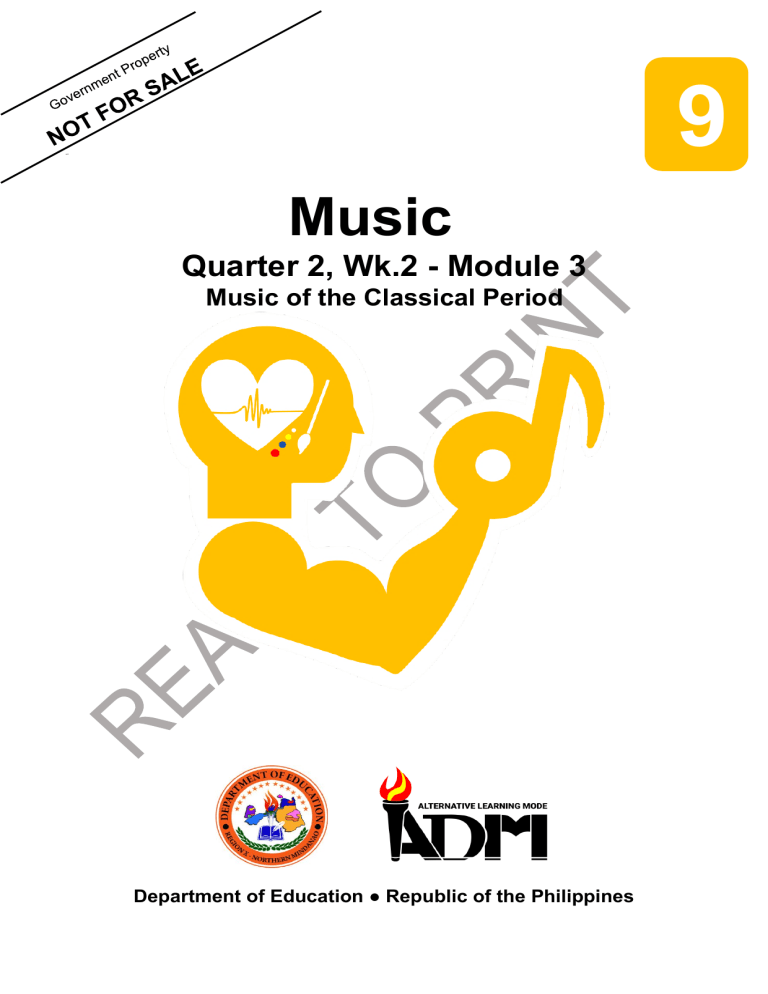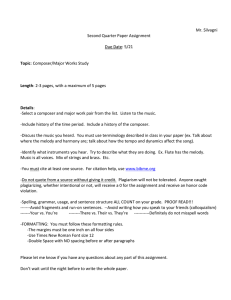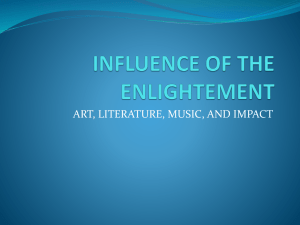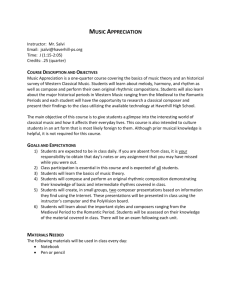
9 NOT Music Quarter 2, Wk.2 - Module 3 Music of the Classical Period Department of Education ● Republic of the Philippines Music - Grade 9 Alternative Delivery Mode Quarter 2, Wk.2 - Module 3: Music of the Classical Period First Edition, 2020 Republic Act 8293, section 176 states that: No copyright shall subsist in any work of the Government of the Philippines. However, prior approval of the government agency or office wherein the work is created shall be necessary for exploitation of such work for profit. Such agency or office may, among other things, impose as a condition the payment of royalty. Borrowed materials (i.e., songs, stories, poems, pictures, photos, brand names, trademarks, etc.) included in this book are owned by their respective copyright holders. Every effort has been exerted to locate and seek permission to use these materials from their respective copyright owners. The publisher and authors do not represent nor claim ownership over them. Published by the Department of Education – Division of Iligan City Schools Division Superintendent: Roy Angelo E. Gazo, PhD., CESO V Development Team of the Module Author: Marie Stela P. Pesiao Evaluators/Editors: Joseph T. Cinco, Violeta B. Calabio Illustrator and Layout Artist: Sheila P. Zarzuelo, Marie Stela P. Pesiao Gianna Norma Stefani D. Mercado Management Team Chairperson: Roy Angelo E. Gazo, PhD., CESO V Schools Division Superintendent Co-Chairpersons: Shambaeh A. Abantas-Usman, PhD. Assistant Schools Division Superintendent Members Henry B. Abueva, CID Chief Nanette Kay D. Mercado, PhD., EPS-MAPEH Rustico Y. Jerusalem, EdD., EPS-LRMS Meriam S. Otarra, PDO II Charlotte D. Quidlat, Librarian II Printed in the Philippines by Department of Education – Division of Iligan City Office Address: General Aguinaldo, St., Iligan City Telefax: (063)221-6069 E-mail Address: iligan.city@deped.gov.ph 9 Music Quarter 2, Wk.2 - Module 3 Music of the Classical Period This instructional material was collaboratively developed and reviewed by select teachers, school heads, Education Program Supervisor in MAPEH of the Department of Education - Division of Iligan City. We encourage teachers and other education stakeholders to email their feedback, comments, and recommendations to the Department of Education-Iligan City Division at iligan.city@deped.gov.ph or Telefax: (063)221-6069. We value your feedback and recommendations. Department of Education ● Republic of the Philippines Table of Contents What This Module is About ................................................................................................................... i What I Need to Know .............................................................................................................................. ii How to Learn from this Module ...........................................................................................................ii Icons of this Module ...............................................................................................................................iii What I Know ........................................................................................................................................... iii Lesson 1: Music of the Classical Period ...........................................................................................8 What’s In ........................................................................................................................8 What I Need to Know..................................................................................................9 What’s New ................................................................................................................ 10 What Is It ................................................................................................................... 11 What’s More ............................................................................................................... 12 What I Have Learned ………………………………………………………….13 What I Can Do .......................................................................................................... 14 Summary Assessment: (Post-Test) Key to Answers .................................................................................................................................. 16 References ........................................................................................................................................... 17 What This Module is About In this module, you may learn the authentic and foundation of the Classical period. Within the history of Western music, the term Classical alludes to the period from 1750-1820. Amid this time, there were noteworthy changes in melodic shapes and fashion recognizing the music from those of the past period Modern music shapes risen such as sonata, concerto and ensemble. The improvement of the Sonata shape driven to more large-scale works and other long instrumental compositions such as ensembles concerts and suggestions. The life and music of Franz Joseph Haydn, Wolfgang Amadeus Mozart and Ludwig Van Beethoven, the three most noteworthy and most celebrated composers of the Classical period will be examined within the taking after pages. In this module, learners will clarifies the execution hone (setting, composition, part of composers/performers, and group of onlookers) amid Classical period. What I Need to Know CONTENT STANDARD ➢ The learner demonstrates understanding of characteristic features of music of the Classical periods. PERFORMANCE STANDARD ➢ The learner sings and performs theme of symphonies and other instrumental forms. OBJECTIVES: ➢ Explain the performance practice (setting, composition, role of composers/performers, and audience) during classical period. How to Learn from this Module To achieve the objectives cited above, you are to do the following: • Take your time reading the lessons carefully. • Follow the directions and/or instructions in the activities and exercises diligently. • Answer all the given tests and exercises. Icons of this Module What I Need to Know This part contains learning objectives that are set for you to learn as you go along the module. What I know What’s In This is an assessment as to your level of knowledge to the subject matter at hand, meant specifically to gauge prior related knowledge This part connects previous lesson with that of the current one. What’s New An introduction of the new lesson through various activities, before it will be presented to you What is It These are discussions of the activities as a way to deepen your discovery and understanding of the concept. What’s More These are follow-up activities that are intended for you to practice further in order to master the competencies. What I Have Activities designed to process what you Learned have learned from the lesson What I can do These are tasks that are designed to showcase your skills and knowledge gained, and applied into real-life concerns and situations. MUSIC OF THE CLASSICAL PERIOD Lesson 2 What’s In Individual Activity: Music & Match Listen to each recording then match the title of the cartoon show/movie in column B to the title in column A. Write your answer n the blank before each number. A ______1. Piano Sonata no.11 in A Major (“Rondo”) 3rd mov. B a. “Mr. Bean” b. “Little Einstein’s” ______2. Piano Sonata no. 14 in C # Minor (“Moonlight”) 1st movement c. “Tom & Jerry” ______3. Symphony no. 5, Op. 67, Cm d. “Popeye” ______4. “Fur Elise” e. “The Ring” ______5. “Eine Kleine Nachtmusik” f. “Backyardigan” What I Need to Know OBJECTIVES: At the end of the lesson, the students are expected to: • Explain the performance practice (setting, composition, composers/performers, and audience) during classical period. role of What’s New INDIVIDUAL ACTIVITY: MATCH ME! Direction: Match column A with column B. Choose your answer in column B that corresponds to the pictures in Column A. Write your answer on the blank before each number. A _____ 1. B a. Franz Joseph Hayden ______ 2. b. Wolfgang Amadeus Mozart ______ 3. c. Ludwig Van Beethoven REFLECTION: 1. Describe the 3 composers of classical period. 2. Among the 3 composers, who do you like the most? Why? What Is It COMPOSERS OF THE CLASSICAL MUSIC Franz Joseph Hayden (1732-1809) He is one of the foremost unmistakable composers of the Classical Period. His life depicts as a “rags-to-riches” story. He came from a destitute family and his music driven to rise in social status. He was enlisted by wealthy supporters and executive for the Esterhazy family for 30years. His music reflects his character and identity: basically calm, adjusted, genuine but with touches of humor. He was able to compose over 100 symphonies and created them into long shapes for expansive ensemble. He was named, “Father of the Symphony” in spite of the fact that he exceeded expectations in each music sort of the period. Most of his ensembles have nicknames such as the “Surprise Symphony”, “The Clock”, and “The Military”. He moreover composed chamber piano music and choral works. Wolfgang Amadeus Mozart (1756-1791) He is a child wonder and the foremost astonishing virtuoso in melodic history. At age five, he was as of now playing the violin and the harpsichord; at six, he was recognized as an extraordinary piano player, and at seven, he was as of now composing fabulous music. At age thirteen, he had composed sonatas, concertos, ensembles, devout works, and musical dramas and operettas. He tested in all sorts of music and composed over 700 works. Shockingly, due to fumbled funds he lived his life in destitution, kicked the bucket youthful, and was buried in an obscure grave. He composed brilliant concertos, symphonies, and operas such as “The Marriage of Figaro” (1786), “Don Giovanni” (1789), and “The Magic Flute “which became popular. Ludwig Van Beethoven (1770-1827) He was born in Bonn, Germany to a family of perform and studied music at an early age. He was the composer who bridged the late Classical era and the early Romantic era. He was a skilled piano player and composer. His celebrated compositions incorporate 32 piano sonatas, 21 set of variations, 9 symphonies, 5 concertos for piano, 16 string quartets, and choral music. His works include the “Missa Solemnis” (1818-1832) and opera “Fidelio” (1805). He began to go deaf in 1796 but this did not ended up an obstacle. He proceeded composing through the assistance of a partner and hearing contraption. A few of his popular compositions were made when he was deaf. What’s More INDIVIDUAL ACTIVITY: NEWSCASTING Procedure: 1. Each student will choose a composer of Classical period. 2. They are going to newscast the life of the composer in a creative way. 3. Perform it in front of the class. Criteria Delivery-------------------_-----15% Pronunciation/diction--------20% Voice Quality------------------15% __________________________________ Total-------------------------------50% Reflection 1. What are the great qualities of the composer that inspire you? 2. Why you choose to newscast the life of the composer? What I Have Learned INDIVIDUAL ACTIVITY: MUSIC CHART Fill in the chart below with information about the composer of classical period. COMPOSER 1. 2. 5 FACTS ABOUT THE COMPOSER 3. 4. 5. 1. COMPOSITIONS TITLE 2. 3. COMPOSER 1. 2. 5 FACTS ABOUT THE COMPOSER 3. 4. 5. 1. COMPOSITIONS TITLE 2. 3. COMPOSER 1. 2. 5 FACTS ABOUT THE COMPOSER 3. 4. 5. 1. COMPOSITIONS TITLE 2. 3. What I Can Do INDIVIDUAL ACTIVITY: COMIC STRIP Procedure: 1. Student will choose a composer of classical period. 2. Let them create a comic book based on the life story of a composer. 3. In a long bond paper at least 10 frames Criteria Content------------50% Creativity---------30% Neatness----------20% _____________________ Total------------100% Summary At the conclusion of the unit, you must have information of the taking after concept. Classical music alludes to the period from 1750-1820. It is additionally known as the “Age of Reason” or “Age of Enlightenment” because reason and independence instead of convention were emphasized in this period. Amid this period, distinctive instrumental shapes of music were created. These were sonata, concerto, and symphony. These three most prominent and most well-known composers of the period are: Franz Joseph Haydn, Wolfgang Amadeus Mozart, and Ludwig Van Beethoven. Assessment: (Post-Test) I. Multiple Choice. Direction: Encircle the letter of the correct answer. 1. It literally means “harmonious sounding together”. a. Sonare c. Sinfonia b. Sonaire d. Sinfona 2. In what year did Ludwig Van Beethoven began to deaf? a. 1976 c. 1796 b. 1967 d. 1769 3. What sonata allegro form that introduces the theme? a. Recapitulation c. Development b. Exposition d. Allegro 4. Who was a composer that described his life as a “rags-to-riches” story? a. Franz Joseph Haydn c. Wolfgang Amadeus Mozart b. Ludwig Van Beethoven d. Johann Sebastian Bach 5. It is called “The Age of Reason”. a. Medieval c. Baroque b. Renaissance d. Classical 6. A musical composition designed to be played by the full orchestra. a. Symphony c. Concerto b. Sonata d. Cantata 7. He experimented all kinds of music and composed over 700 works? a. Franz Joseph Haydn c. Wolfgang Amadeus Mozart b. Ludwig Van Beethoven d. Johann Sebastian Bach 8. Sonare which means” ____________________.” a. to make a sound c. to make a noise b. to make a music d. to make a work 9. A section of sonata allegro form wherein themes are being developed. a. Recapitulation c. Development b. Exposition d. Sonata 10. How many years did Franz Joseph Haydn became a musical director for Esterhazy family? a. 20 years c. 30 years b. 10 years d. 40 years II. Identification: Identify the composer of each vocal and instrumental works. ____________________________11. Fidelio ____________________________12. The Marriage of Figaro ____________________________13. The Clock ____________________________14. Missa Solemnis ____________________________15. The Military ____________________________16. Surprise Symphony ____________________________17. The Magic Flute ____________________________18. Pastoral ____________________________19. Don Giovanni ____________________________20. Eroica Key to Answers I. Multiple Choice 1. c 2. c 3. b 4. a 5. d 6. a 7. c 8. a 9. c 10. c II. Identification 11. Ludwig Van Beethoven 12. Wolfgang Amadeus Mozart 13. Franz Joseph Haydn 14. Ludwig Van Beethoven 15. Franz Joseph Haydn 16. Franz Joseph Haydn 17. Wolfgang Amadeus Mozart 18. Ludwig Van Beethoven 19. Wolfgang Amadeus Mozart 20. Ludwig Van Beethoven References • Included all third party materials or sources in developing the material • Follows the Chicago Manual of Style 17th edition For your guide, https://owl.purdue.edu/owl/research_and_citation/chicago_manual_17th_edition/cmos_form atting_and_style_guide/chicago_manual_of_style_17th_edition.html you can also use citation machine generators: citethisforme.com and citefast.com https://www.google.com/search?q=ludwig%20van%20beethoven&tbm=isch&safe=active&sa fe=active&tbs=sur%3Afc&hl=enUS&ved=0CAIQpwVqFwoTCPDtn92XyekCFQAAAAAdAAAAABAC&biw=1017&bih=554#im grc=dpAh3P_i5YxMIM https://www.google.com/search?q=franz%20joseph%20haydn&tbm=isch&safe=active&safe =active&tbs=sur%3Afc&hl=en&ved=0CAIQpwVqFwoTCJiGuaafyekCFQAAAAAdAAAAABAJ &biw=1017&bih=554#imgrc=v0FjqunwQyt3MM https://www.google.com/search?q=Wolfgang%20Amadeus%20Mozart&tbm=isch&safe=activ e&safe=active&tbs=sur%3Afc&hl=en&ved=0CAIQpwVqFwoTCPimuuSfyekCFQAAAAAdAA AAABAC&biw=1017&bih=554#imgrc=LfXh_8trMyM1QM For inquiries and feedback, please write or call: DepEd Division of Iligan City Office Address: General Aguinaldo, St., Iligan City Telefax: (063)221-6069 E-mail Address: iligan.city@deped.gov.ph


